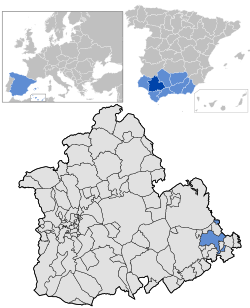Estepa
| Estepa | |||
|---|---|---|---|
| Municipality | |||
|
|||
| Motto: Latin: Ostippo, Quid Ultra? (Estepa, What else?) |
|||
 |
|||
| Location in Spain | |||
| Coordinates: 37°17′30″N 4°52′45″W / 37.29167°N 4.87917°WCoordinates: 37°17′30″N 4°52′45″W / 37.29167°N 4.87917°W | |||
| Country |
|
||
| Autonomous community |
|
||
| Province | Sevilla | ||
| Comarca | Sierra Sur de Sevilla | ||
| Founded | 1241 | ||
| Government | |||
| • Alcalde | Juan García Baena (PSOE) | ||
| Area | |||
| • Total | 202.42 km2 (78.15 sq mi) | ||
| Elevation | 604 m (1,982 ft) | ||
| Population (2008) | |||
| • Total | 12,547 | ||
| • Density | 62/km2 (160/sq mi) | ||
| Demonym(s) | Estepeño/a | ||
| Time zone | CET (UTC+1) | ||
| • Summer (DST) | CEST (UTC+2) | ||
| Postal code | 41560 | ||
| Website | Official website | ||
Estepa is a municipality in the extreme south-east of the province of Seville. Its population was 12.631 inhabitants in 2013. The town is located north of the Sierra del Becerro mountains.
Estepa possesses a very ancient past and has well-preserved remains to testify to this. Some date back to prehistory including flint tools and axes. The remains reveal the later accession of Carthaginian people. At least two settlements are known: one situated in Los Canterones, shown by ancient deposits some 6 km from the town of Estepa, and the other under present-day Estepa.
Estepa is mentioned in classical sources as Astapa and Ostippo. The Romans destroyed the Carthaginian city of Astapa during the Punic Wars, as described by Titus Livius. In the Roman epoch, the town bore the name Ostippo, a free city linked to the Conventus de Astigi (Écija). It was mentioned in the Antonine Itinerary. The Roman city would have occupied the high part of the site, but little evidence remains. Numerous remains of agricultural developments suggest many small populations in the plains to the north of Estepa.
The place continued to be inhabited during the Visigothic period. Under the Arabs it adopted the name Istabba, and the poet Al Zawwali lived there for a while. In 1267, having been taken by Fernando III during the Christian reconquest, the town was handed over to the Order of Santiago, to take charge of its defence as a frontier position. Its greatest monumental and artistic achievements were attained during the 16th and 17th centuries under the marquesses of Estepa; their palace was built on the site of the former Islamic fortress.
By the 19th century, although Estepa was expanding, the palace was in ruins and the area was known for banditry. The town was granted the title of "city" (ciudad) in 1886. During the Civil War it was soon taken over by Franco's forces. After the war, widespread poverty led to substantial emigration to industrial areas of Spain and other European countries during the 1950s and 1960s; the population remained at a constant level. Social conflict was still present in the area after the return to democracy in Spain, as seen in a strike of agricultural workers in 1990.
...
Wikipedia



